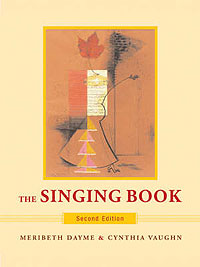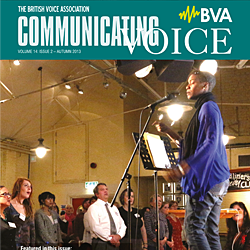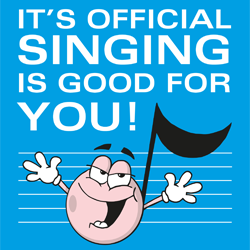About the Association
Archived book reviews

The Singing Book
Meribeth Dayme and Cynthia Vaughn
Published by: W.W. Norton
Overview by the Editor and reviews by Beth Shouler and Joanna Hudson, July 2008
Editor's overview…
I decided to give two student teachers the opportunity to review this book as I felt it would be an excellent resource for their training.
There were however aspects I felt I would highlight in this comprehensive tome; the need for an explanation of terminology, the importance of setting parameters as well as goals in practice habits and the importance of foreign languages and their pronunciation.
Many of the songs I've used in my teaching and I was heartened to see them included here although I felt the range in some of the Popular Songs examples had a low range so care would be needed with a younger singer to allow time to grow those notes. On a practical note, my copy came back quite dog-eared and I wonder if a more substantial cover would better withstand the rigours of a student holdall.
Review by: Beth Shouler
MA (Freelance drama teacher working for City Arts projects and Youth Offending Team)
The Singing Book is a great introduction to singing, especially for those who are starting out for the first time and would enjoy a manual to use alongside singing lessons. The book is split into three sections. The first section outlines preparing to sing: looking at practice, selecting music, performing and the reasons why people sing. It is particularly encouraging to those without a musical background or who may be lacking confidence in their vocal ability.
Dayme and Vaughn use their book to decode many of the myths surrounding singing and performance and I found this truly refreshing and useful! The second section of the book contains examples of different types of music with some brief guidance on how to approach these songs according to the genre and then more specifically to the history of each piece of music. It is fantastic to have everything you need to sing in one book without having to spend a fortune on separate music! Potentially this could help you identify the sort of music you most enjoy singing.
The book contains 2 CD recordings to accompany you. Each recording starts with a beat to guide you into the tempo and then the music kicks in. Unfortunately the quality of the recordings isn't brilliant – the piano accompaniments are dull, but do the job. However some of the other instruments sound very synthesised to me and grated on my nerves but at least it meant I could sing along in the car and got to know some of the songs without relying on hearing other people's recordings (this always seems to colour my own interpretation) or being able to play the piano (I gave up after grade 2!). The third section looks in more detail at the anatomy and physiology of the voice. it includes some fantastic diagrams of the body and vocal exercises for you to identify how parts of your voice operate. This enables you to explore your voice confidently and with understanding rather than guesswork that you are getting it right.
One of the things I most enjoyed is the simplicity of the descriptions and the holistic approach to singing. While it contains a great deal of technical knowledge it also puts this into the context of looking after the body both physically and psychologically. It acknowledges that often the problems we have with our voices come from inhibitions, learnt behaviour and poor physical health and are not because someone has a 'bad voice'. It doesn't look at these in much depth but puts forward some ideas that may well help the inexperienced singer identify some of the issues they are having. Personally I struggle with confidence when singing and have that horrible habit of comparing my voice with others.
The authors encourage people to use and explore their voices, implying that everyone has a unique voice worth discovering that is capable of sounding decent. Their emphasis is on vocal health and building confidence so that singing is a fun experience and performing is satisfying. I found this attitude really helpful and it made me feel more positive about some of the struggles I have. The back of the book contains vocal exercises for warm ups, worksheets, information on pronunciation, an introduction to reading music and a list of useful websites for more in depth information.
I would especially recommend The Singing Book to adult beginners for use alongside lessons, or singers looking for a greater understanding of their voice without having to spend hours reading complicated scientific texts, or for those whose vocal confidence is quite low. Overall this is an enjoyable, engaging and thorough introduction to the voice and singing.
Review by: Joanna Hudson
(singer)
In the preface, Meribeth Dayme and Cynthia Vaughn describe The Singing Book as "designed to help the beginning singer develop fundamental habits of singing that are both healthful and easy and to provide useful guidelines and a repertoire collection for those who already have some background in singing." I agree and think it would be an equally useful reference to anybody starting lessons.
The Singing Book takes you through all areas of singing starting with vocal warm-ups through to choosing and learning new songs. It gives guidance on performing techniques and takes you on a journey around the whole body explaining that every part of a singers' body, from the feet to the head, and their emotional state can have a massive effect on the voice. I particularly found some of the visualisation techniques for learning songs very effective and advice on pre-performance nerves was also very useful.
There is a great introduction to the mechanics of the singing voice. I find learning about the physicality of the larynx and throat quite hard to understand, but included are clear pictures and excellent descriptions so I felt that I understood a lot more. I particularly liked the sections called ‘finding out for yourself' which appear regularly throughout each chapter. These short sections give practical hands-on exercises to do at home which help the reader to understand the theories being discussed in the book, as a student teacher I will use these exercises in lessons.
Overall I think The Singing Book is written in a very accessible manner with a fun, practical approach which I am sure pupils' would find interesting and educational.
More archived content online
Disclaimer
Neither the British Voice Association nor the Editor can be held responsible for errors or any consequences arising from the use of information contained in its newsletters (or extracts from its newsletters published online); the views and opinions expressed do not necessarily reflect those of the British Voice Association (BVA) or the Editor, neither does the publication of advertisements constitute any endorsement by the BVA or Editor of any products or services featured.

 Join us Now!
Join us Now! our newsletter
our newsletter free voice care leaflets & information – download here
free voice care leaflets & information – download here Help our work by donating while you shop
Help our work by donating while you shop